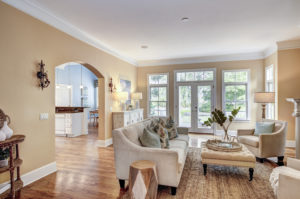
The ceiling – your home’s fourth wall – is often an overlooked area for ornamental style. Add some punch with crown molding and give your rooms timeless formality and visual depth.
What Is Crown Molding?
Crown molding is a decorative trim that runs along the edge of the ceiling that’s used to finish interior walls, cabinets and columns. It’s only used at the top of the room, which is how it got is “crown” name.
This architectural upgrade comes in a variety of materials including:
- Flex – This rubbery material lets you bend your molding around curved walls without needing cuts.
- MDF – Medium density fiberboard is a low-cost, stable alternative to wood, but it must be painted.
- Plaster – This traditional material is made to order, heavy, easily cracked but can be shaped elaborately
- Polystyrene – This can be cut with a knife or scissors and sticks to the wall with construction adhesive. But it also doesn’t look as professionally finished as the other types and should be considered a quick style fix.
- Polyurethane – This increasingly common material is rot- and insect-resistant (unlike wood) and can be made into the same types of elaborate designs as plaster. Like MDF, it’s only good in PVC – Plastic PVC crown molding is perfect for humid spaces like bathrooms or laundry rooms. It requires painting to cover its shiny surface.
- Wood – Another traditional material that can be formed into different shapes; the downside is, if improperly finished, the molding can shrink and swell in the presence of humidity painted applications.
Crown Molding Ideas
Here are some ways to use crown molding.
- Dress up cabinets – Use this molding to finish the tops of the cabinets to cover cabinet edges and add elegance to a kitchen.
- Frame a cased opening – In rooms with wide cased openings or archways, adding crown molding defines the space, beautifully.
- Install it at the top of the wall – This is the traditional way of using crown molding, by mounting it at a 45-dgree angle where the ceiling and wall meet.
- Make a bookshelf look built in – With this smart hack, adding crown molding to the top of a bookshelf – or a row of shelves – makes them look like expensive built-ins.
- Trim out a window – Trimming a window with crown molding makes windows look brighter and bigger.
Are There Rooms That Shouldn’t Have Crown Molding?
Like most style solutions, crown molding isn’t the answer for every space. Since this is a traditional architectural feature, it doesn’t suit modern homes.
It also doesn’t work well with certain ceilings, like vaulted or cathedral ceilings. And in open-plan homes, which don’t have distinct starting and stopping points, it could be hard to find logical beginning and ending points for the molding to wrap.
Rooms with low ceilings are a toss of the dice. In some cases, it can make the room feel smaller, but in others, it can give the room a gracious and welcoming air. Work with your carpenter to figure out whether this is a solution for you.
Our interior painting pros are experts at painting all types of trim, including crown molding. Start with a fee estimate today. Or browse our trending colors and order free 8’ x 8’ color samples.